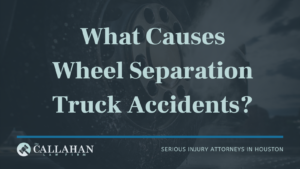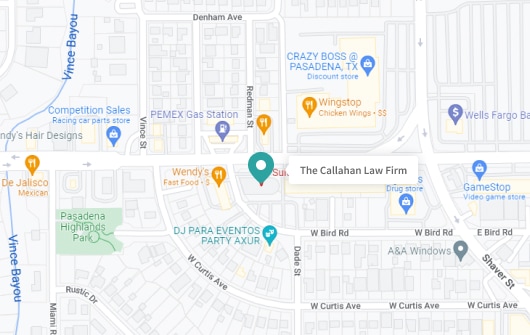What Causes Wheel Separation Truck Accidents?

Despite advancements in truck safety, wheel separation truck accidents remain a leading cause of vehicle crashes. What causes these wheel separation accidents?
Wheel separation truck accidents occur when the wheel of a truck unexpectedly detaches while in motion. To be clear, the wheel is the circular metal structure that attaches to the wheel hub assembly and axle of a vehicle. The rubber tire is then secured to the wheel. Wheel separation accidents can have devastating consequences, leading to injuries, loss of lives, and significant property damage.
It is estimated that approximately 1,000 trucks are involved in wheel separation truck accidents nationwide each year, and a FMCSA report stated that over 400,000 tire separations caused accidents and damage to road users in 2020.
This article will explore the factors contributing to wheel separation truck accidents and the preventative measures one can take to salvage the situation or stop it from happening altogether.
What are Wheel-Off Truck Accidents?
Wheel-off, or wheel separation, truck accidents are accidents in which a tractor truck or 18-wheeler loses a wheel while driving. The wheel separates from the vehicle and gets flung into the road, becoming a major hazard for other drivers.
These accidents are extremely dangerous because they often occur at high rates of speed, meaning nearby drivers may not have time to react and be unable to avoid hitting the loose wheel. A truck wheel with tire can weigh over 100 pounds, and, as you can imagine, the weight and speed of a separated wheel can lead to serious injuries.
What’s more, losing a wheel can cause the truck driver to lose control of the vehicle, increasing the chances of an accident. If the truck overturns, it may cause a rollover accident, which could cause other drivers to be seriously injured.
Types of Wheel Separation Accidents
Wheel separation can happen in two different ways:
- complete detachment and
- partial detachment
The entire wheel comes off the truck in a complete detachment, whereas partial detachment involves the wheel coming loose but not entirely detaching, leading to instability and potential accidents.
What are the Common Causes of Wheel Separation Truck Accidents?
Trucking companies are required by law to ensure their vehicles are well-maintained and pass inspection before they can be driven on a public road. Unfortunately, trucking companies all too often lack appropriate care and take shortcuts when employing drivers, maintaining their vehicles, and conducting pre-trip inspections. Failing to maintain and inspect the wheels and tires of a tractor truck or 18-wheeler can cause major issues, leading to a wheel separation truck accident.
Wheels can come off of a truck for several reasons, but knowing the most common causes of wheel separation accidents can help truck drivers prevent these accidents from taking place. Some of the more common causes of wheel separation accidents can include:
- Axle problems: Old, worn, or broken axles can cause wheel separation truck accidents to occur. Installing the axle nut too loosely or tightly can also cause bearing failure and result in a wheel separation.
- Faulty Wheel Installation: The National Transportation Safety Board determined that 40 percent of all-wheel violations occurred due to loose or missing nuts or studs. It is extremely important for mechanics to tighten lug nuts to the proper torque values. If the wheel’s lug nuts are under-torqued, they may gradually loosen until the wheel falls off. If the nuts are over-torqued, the force may put too much pressure on the nut, causing the nut to break or fracture and the wheel to fall off.
- Auto Part Defects: If the tire, wheel, or other pieces are defective, they may break and cause a wheel separation truck accident. Auto parts manufacturers are responsible for ensuring their products are safely and correctly made. Additionally, mechanics and the trucking companies that hire them should be well-trained and equipped to inspect the truck before approving it for transit.
- Excessive Heat: An estimated 25% of wheel separation accidents are caused by excessive heat. If the inner wheel is leaking lubricant, the loss of lubricant can cause the metal pieces to heat up due to excessive pressure and friction. If this occurs, one or more of the wheel connections can sheer off or break, causing a wheel separation truck accident.
The above list of causes are all preventable and can often lead back to poor maintenance, inadequate inspection, and negligence. Let’s take a closer look at what role human error plays in wheel separation accidents.
Human Error: Major Cause of Wheel Separation Truck Accidents
Human error plays a significant role in wheel separation accidents because truck drivers and maintenance crews can inadvertently contribute to these incidents. Understanding these potential errors can help us implement better training and communication to reduce the risk of accidents.
- Lack of Proper Training: Truck drivers must be adequately trained in wheel maintenance and inspection to avoid potential issues that could lead to wheel separation accidents.
- Failure to Report Potential Issues: Drivers may sometimes notice warning signs of wheel problems but fail to report them promptly or defer necessary maintenance, leading to delays in addressing the concerns.
- Ignoring Warning Signs: Trucks have dashboard indicators that signal potential wheel-related problems. Ignoring these warnings can lead to severe consequences on the road.
- Inadequate Training and Qualifications: If maintenance crews lack the necessary expertise and training, they might perform subpar wheel maintenance, increasing the risk of wheel separation.
- Rushed or Improper Maintenance Practices: Maintenance workers might overlook essential checks in a fast-paced environment, resulting in unaddressed issues that can lead to accidents.
- Ineffective Communication: Lack of clear communication between truck drivers and maintenance teams can lead to misunderstandings, causing crucial wheel-related information to be overlooked.
Comprehensive training programs for drivers and maintenance crews are essential to reduce human error’s impact on wheel separation accidents. Encouraging open communication and promptly addressing potential issues can go a long way in ensuring safer roads.
External Factors and Road Conditions That Cause Wheel Separation Truck Accidents
Besides maintenance and human errors, external factors and road conditions can also contribute to wheel separation truck accidents. Knowing how these elements influence wheel safety is crucial in devising strategies to prevent accidents caused by external factors. These factors include:
- Potholes and Road Hazards: Poor road conditions, such as potholes and other hazards, can place excessive stress on truck wheels, leading to potential detachment.
- Rough Terrain: Traveling on rough and uneven terrain can accelerate wear and tear on wheels, making them more prone to failure.
- Frequency of Wheel Separation on Specific Roads: Some roads may have a higher incidence of wheel separation accidents due to their conditions or construction materials.
- Influence of Extreme Weather on Tire Integrity: Harsh weather, such as extreme heat or cold, can affect tire materials and compromise their structural integrity, increasing the risk of tire failure as well as wheel separation.
- Effects of Temperature Changes on Tire Pressure: Drastic temperature fluctuations can cause changes in tire pressure, affecting the wheels’ grip and stability on the road.
- Weather: Wet or icy road surfaces can reduce traction and control, making it more challenging for drivers to maintain control of the truck’s wheels. Besides frigid weather conditions, excessive heat can also contribute to a wheel separation incident.
Preventing Wheel Separation Truck Accidents
Routine maintenance can play a large role in preventing wheel separation truck accidents.
Establishing Regular Inspection Schedules
Implementing a scheduled maintenance program ensures that truck wheels are regularly checked for signs of wear, damage, and potential issues.
Training Drivers and Maintenance Crews
Educating drivers and maintenance crews on wheel maintenance practices and safety protocols equips them to identify and address problems effectively.
Implementing Preventive Maintenance Protocols
Regular maintenance tasks like torque checks, wheel alignments, and tire rotations can significantly reduce the risk of wheel separation accidents.
Preventing Wheel Separation Truck Accidents
The NTSB estimates that the nation sees anywhere between 750 and 1050 wheel separation truck accidents yearly. However, these figures only include wheel separation incidents that result in a truck accident, and safety experts believe that many more wheel separation accidents that don’t result in accidents go unreported.
In Canada, safety advocates have argued for an absolute liability law for wheel separation truck accidents, increased fines for wheel separations, specialized training for mechanics and technicians who work with wheel installations, and additional road inspections. In addition, new technology from a Canadian company hopes to help mitigate this issue.
The company, called LWS (for “loose wheel sensors”), created small sensors that can be fitted onto the studs between the wheel and the lug nut. When fitted, the LWS sensors can detect extreme heat and the gradual loosening of lug nuts and flashes an indicator light to alert the driver what and where the issue is.
However, until these practices and safety upgrades are made mandatory in the states, wheel separation truck accidents will continue to endanger truckers and drivers.
What Should I Do if I’ve Been in a Wheel-Off Truck Accident?
Those hurt in a wheel separation accident should immediately contact an experienced truck accident attorney. There are many reasons why a wheel separation truck accident might occur, which means several parties may be at fault, including the truck driver, the trucking company, the truck manufacturer, and other parties, such as repair shops or mechanics responsible for maintaining the vehicle.
A truck accident lawyer can help determine why the wheel separated from the vehicle by demanding preservation of evidence, inspecting the at-fault vehicle, gathering truck maintenance records, and retaining appropriate experts such as accident reconstructionists and truck mechanics to determine the circumstances of the accident and who was at fault.
If you or a loved one has been injured in a trucking accident, contact The Callahan Law Firm today to speak with an attorney. Our Texas Truck Accident Lawyers have been helping injured people and their families for over 25 years, and we can help you too. Call us at 713-224-9000, or fill out our contact form here.
FAQs: Frequently Asked Questions
Q: What is the difference between a wheel separation and a tire separation?
A: A wheel separation is when the wheel of a vehicle detaches while in motion. The wheel is the circular metal structure that attaches to the wheel hub assembly and axle of a vehicle. The rubber tire is then secured to the wheel. A tire separation happens when the rubber tire separates from the metal wheel.
Q: What causes tire sidewall separation?
A: Tire sidewall separation, also known as “tire delamination,” is often caused by the breakdown of the tire’s internal components, particularly the bonding between the layers of the tire.
Q: How common is wheel separation and tire separation?
A; Wheel separation and tire separation are not an everyday occurrence, but they do happen. The likelihood of experiencing wheel or tire separation can be minimized by proper tire maintenance, regular inspections, ensuring wheels are securely bolted in place and not over-torqued, and replacing tires when they reach the end of their recommended service life.

Michael S Callahan is an attorney and founder of The Callahan Law Firm. He focuses his practice on representing individuals and families in personal injury cases involving motor vehicle and truck accidents, workplace accidents and defective products. With over 25 years of experience, he is dedicated to fighting on behalf of people whose lives have been forever altered by the negligence and carelessness of corporations and individuals. Originally trained as a mechanical engineer, Michael has been practicing law and fighting for justice for those who need it most since 1994. He is board-certified in Personal Injury Trial Law by the Texas Board of Legal Specialization and a member of various esteemed legal associations. Outside of work, Michael enjoys spending quality time with his family, outdoor activities, and continually striving to improve as a trial lawyer and human being.











